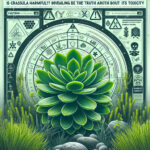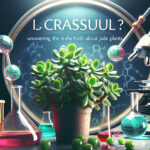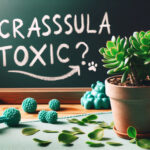Introduction to Crassula Plants
Welcome to the wondrous world of Crassula, a genus that’s taken the houseplant market by storm! Now, you might be pondering, “What’s all the fuss about these green beauties?” Let me tell you, these aren’t just your garden-variety plants; they’re the superheroes of the succulent league!
Imagine this: You’ve just stepped into a friend’s apartment and BAM! Your eyes are drawn to a stunning, emerald array of Crassula plants basking in the sun, gracing the room with a vibrant splash of greenery. This isn’t a coincidence; the Crassula genus, with its thick, fleshy leaves that store water, are the perfect companions for the forgetful waterers and the busy bees among us. They’re hardy, they’re resilient, and most importantly, they’re oh-so-easy to love.
But it’s not just their low-maintenance charm that’s captivated hearts. The Crassula genus boasts a diversity that’s a feast for the eyes—ranging from the classic Jade Plant to the quirky ‘ET’s fingers’. Each species flaunts its unique quirks, from intricate leaf patterns to peculiar growth habits that can turn any nook into a botanical wonderland. And just when you think you’ve seen them all, another Crassula variety pops up to surprise you.
For those looking to dip their toes into the world of gardening, consider this your sign to start with a Crassula. They’re forgiving, they’re adaptable, and they bring a piece of nature right into your living space. In fact, here’s a little insider tip from our experts: the Crassula Jade Care: Tips for a Thriving Succulent Haven guide will help you ensure your Crassula thrives, making your green thumb greener than ever.
But wait, before we delve deeper into the realm of Crassula, let’s not forget one crucial question—is crassula poisonous to humans? Stick around as we unveil the truth, ensuring that your journey with these fantastic plants is not only joyful but also safe. For a visual treat, feast your eyes on this luscious image of Crassula Muscosa seedlings—nature’s own work of art.
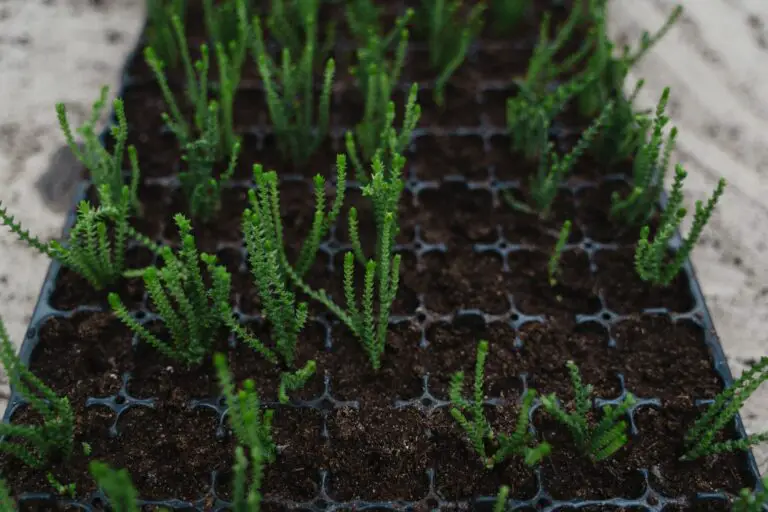
Understanding Plant Toxicity
Ever stopped to smell the roses, and wondered—could this beauty be a beast in disguise? The world of plants is a paradox of allure and armor; they draw us in with their enchanting colors, yet some harbor a secret kickback for those who get too close. They are not hostile by nature; they’ve simply evolved to say, “Back off!” in a chemical language. Plant toxins are nature’s bouncers, chemicals designed to protect these silent entities from predators—a bit like a fairy tale potion brewed in leafy cauldrons.
Take a stroll in the forest, and you might encounter a plant that looks as innocent as Snow White’s apple. In fact, 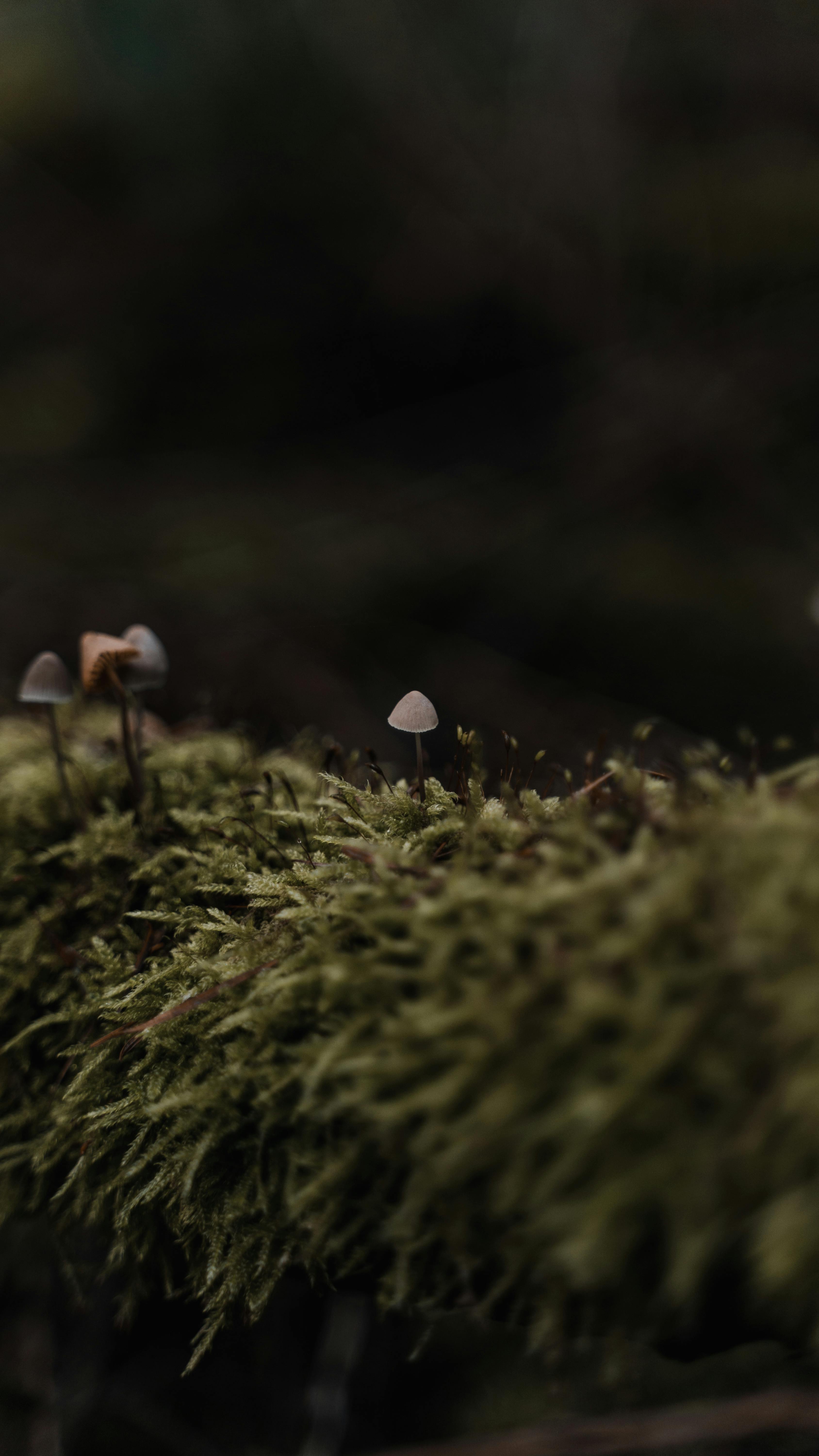 might offer a visual feast, but don’t be fooled. The forest floor or domestic gardens can present a “mixed bag” of botanical treasures, some of which could be laden with toxins causing anything from a mild headache to a dramatic trip to the emergency room.
might offer a visual feast, but don’t be fooled. The forest floor or domestic gardens can present a “mixed bag” of botanical treasures, some of which could be laden with toxins causing anything from a mild headache to a dramatic trip to the emergency room.
But what does “toxic” really mean when we’re talking about our green friends? Well, it’s not always about the doom and gloom of poisonings. It’s about a sophisticated system of defense. Some plants produce compounds that can cause skin irritation upon contact, while others might have parts that are hazardous if ingested. The spectrum of plant toxins can have effects ranging from mild gastrointestinal discomfort to serious effects on the heart and nervous system. It’s crucial to identify and understand the plants we cohabitate with, especially if pets or small children are part of our households.
We’re not just talking about the exotic and the wild—the plants in our homes and backyards can surprise us with their hidden traits. Even the beloved and admired Jade plant, known in the botanic world as Crassula, prompts the question: Is it a friend, a foe, or somewhere in between? Analyzing the actual risk requires a little Sherlock Holmes-style sleuthing, and context is always key. After all, many consumables like almonds and apples host cyanogenic glycosides—same family as the notorious cyanide, yet we snack on them with delight.
The next time you admire a plant, remember it’s a part of a vast ecological web, with each species waving its own chemical flag. The conversation around plant toxicity isn’t about fear; it’s about fostering respect and curiosity for these complex life forms that share our spaces and shape our stories.
Is Crassula Poisonous to Humans?
When it comes to houseplants, safety is a top priority, especially for those with curious children or pets. The Crassula genus, often recognized for species like the Jade Plant, has been the subject of many inquiries regarding its toxicity. Are these elegant succulents a hidden danger in our homes, or is their reputation as a toxic plant a case of mistaken identity?

Delving into the heart of this matter requires us to look through scientific literature and official toxicity reports. It’s a common scenario: a piece of leaf drops to the floor, and before you know it, a child or pet might take a bite. The need to understand the exact toxicity level of Crassula species is not merely academic—it’s a practical concern for countless households.
According to the North Carolina Extension Gardener Plant Toolbox, while there are minor symptoms associated with Crassula ingestion, they are mostly considered low severity. Vomiting or a sense of inebriation in cats, and very rarely, tremors have been reported, but these instances are not the norm. The consensus in the plant community is that most varieties, such as Crassula Ovata, generally lack significant toxic components, making them safer than their reputation suggests.
The real-life implications are evident: for those individuals who have mistakenly chewed on a piece of Crassula or witnessed their pet nibbling on its leaves, the observable reactions were often mild, if any. Scenarios like these underscore the importance of understanding the nuances of plant toxicity. And speaking of care, if you want to ensure your Crassula thrives, take a peek at our guide on flourishing succulents within reach, which goes beyond safety and into the realm of plant care mastery.
In summary, the fear surrounding Crassulas and human health seems to be largely overstated. By focusing on accurate information and taking reasonable precautions, we can appreciate these succulents for what they truly are: beautiful, easy-to-care-for plants that add a touch of green serenity to our lives.
Symptoms of Crassula Toxicity in Humans
Have you ever wondered about the safety of those lush, vibrant Crassula plants, often known as Jade plants, adorning the corners of homes and offices? While these succulents are praised for their low maintenance and aesthetic appeal, a question lingers—is Crassula poisonous to humans? Let’s explore the reality behind the verdant veneer.
Imagine this: You, or perhaps a curious child, accidentally breaks off a piece of Crassula leaf and, out of sheer intrigue, taste-tests it. What follows might be a series of unfortunate events. While Crassula plants are not classified among the most toxic flora, they can indeed cause some unpleasant symptoms if ingested. Now, before you banish your beloved Jade to the outlands, let’s dissect the symptoms that could arise from such a leafy encounter.
Contact with the sap or ingestion of Crassula can lead to a cascade of mild to moderate symptoms. Our bodies are not built to handle these green goodies, and they sure let us know it. Symptoms might include a sense of nausea, making one rue that curious nibble. An untimely bout of vomiting could follow, ejecting the unwelcome green invader. The mouth and throat are not fans of the unexpected guest either, potentially reacting with a fiery irritation or swelling, leaving you with a regret as persistent as the aftertaste.
Let’s not overlook our skin, which might also react to Crassula sap. If the skin decides the plant is persona non-grata, it may show its dissatisfaction through redness, itching, or even a rash. This is the skin’s not-so-subtle way of saying, “stick to the non-succulent décor.”
The severity of these symptoms can vary, mostly serving as a warning that Crassula and the human body are better off in a “look, don’t taste” relationship. Now, don’t panic—these green guys can still share your space safely, as long as we respect their boundaries. Keeping them out of reach from children and pets can prevent any unwelcome plant tasting sessions.
So, while Crassula plants may not be the botanical equivalent of a forbidden apple, they do warrant a bit of caution. It’s always better to admire their jade-like beauty from a distance and leave the taste-testing for things more palatable and people-friendly.

Safely Handling Crassula Plants
Love your lush green Crassula but worried about its safety around your playful toddlers or your curious furballs? Fear not! Here’s your go-to guide for keeping everyone safe while coexisting with this succulent beauty, more commonly known as the Jade Plant. Let’s dive into the world of Crassula without a shred of worry!
First things first, despite its undeniable charm, the Crassula plant can be toxic when ingested. That’s right, those plump leaves can pack a punch if snacked on. So, how do you enjoy its company without the panic button at the ready? It’s simple: strategic placement. Keep your Crassula on a high shelf or in a room that’s off limits to tiny taste-testers and furry explorers. This way, you’re creating a safe zone that’s out of reach for misadventure.
Next up, let’s talk prevention. Education is key! Teach your little ones about the importance of not munching on houseplants. A great way to illustrate this is with a ‘Plants are friends, not food’ policy. It’s a life lesson that extends beyond Crassula and keeps the kiddos safe around all your green companions. And for the pets? A firm ‘no’ and a distraction with their favorite toy should do the trick!
If you suspect that someone has had a bite, don’t wait for the show to start. Be proactive and seek medical or veterinary advice immediately. Bookmark a reliable source like Gardener’s Path on Crassula plant care for speedy access to important information.
Last but not least, let’s not forget about your green thumb safety. Handling the plant for pruning or repotting? Gear up with gloves! This not only keeps your hands sap-free (in case of skin sensitivity) but also ensures a firm grip, so you’re not treating your Crassula like a hot potato.
Remember, the Crassula is more than just a pretty face on your windowsill; it’s a part of your home. With these tips, cohabitation is not just possible; it’s a thriving, worry-free reality. Happy planting!
First Aid: What to Do If Poisoned by a Crassula Plant
The green, jewel-like leaves of the Crassula plant, commonly known as the Jade Plant, are a delightful sight in many homes. However, when it comes to these succulent beauties, there’s a hidden risk that lurks beneath their charm. If you believe you or someone you know might have been poisoned by a Crassula plant, it’s important to remain calm and act swiftly. Here, we peel back the layers of misinformation and give you the concrete steps to tackle such emergencies.

First, let’s set the scene with a real-life scenario: It’s a bright Saturday afternoon. You’re doing some light gardening, pruning your indoor plants, including your Crassula. Suddenly, you nick your finger on one of its edges, and without thinking, you pop your finger into your mouth to soothe the cut. Only moments later, you recall reading about the potential toxicity of Crassula plants. Now what?
Step 1: Identify the Exposure
Figure out how the poison entered the body. Was it through skin contact, ingestion, or inhalation? For our green-thumbed friend, it’s ingestion—a slight misstep that happens more often than you’d think.
Step 2: Don’t Panic, Assess the Situation
It’s crucial not to let anxiety take the driver’s seat. Assess whether there are any immediate symptoms, such as irritation in the mouth or throat, difficulty breathing, or any unusual discomfort. In our scenario, besides the initial shock, our friend feels okay, but it’s better to err on the side of caution.
Step 3: Contact Poison Control or a Medical Professional
If symptoms begin to emerge, seek medical attention immediately. Even if no symptoms are present yet, calling a Poison Control Center or consulting with a doctor can provide guidance tailored to the specific situation. They can advise whether it’s necessary to make a trip to the emergency room or if monitoring at home is sufficient.
Step 4: Follow Professional Advice
Adhere to the instructions given by the medical professional or poison specialist. They may suggest diluting the poison by drinking water or milk, or they might instruct you to avoid ingesting anything if vomiting needs to be induced under medical supervision.
Step 5: Prevent Further Exposure
Avoid contact with the plant until you’re certain of the proper safety measures to take. Secure the plant away from other household members, especially curious pets and children. For our unfortunate gardener, this means taking off those gardening gloves and thoroughly washing hands and other possibly contaminated areas.
Remember, while Crassula plants can be mildly toxic, the severity of the poisoning largely depends on the amount of exposure and the individual’s sensitivity. In most cases, being prudent and informed will keep both you and your beloved plants flourishing harmoniously.
Choosing the Right Houseplants: Toxic vs Non-Toxic Varieties
When it comes to sprucing up your indoor space, nothing breathes life into a room quite like houseplants. They’re not just decor; these green companions can elevate your mood, purify the air, and even add a touch of the serene to the chaos of daily life. But it’s not all about picking the prettiest leaves or the most vibrant blooms—the safety of your family and pets must take root in your decision process. Let’s dig into how you can select non-toxic varieties that ensure your home is as safe as it is green.
Imagine you’re at the nursery, and your eyes fall on a stunning Jade Plant, also known as Crassula. It’s lush, it’s hearty, but is Crassula poisonous to humans? You remember hearing some cautionary tales about its toxicity. Well, fret not. While Crassula can be a concern for furry friends, it’s generally considered non-toxic to humans. However, this example underscores the importance of doing your homework. Not all plants are created equal, especially when it comes to their interactions with two-legged and four-legged inhabitants.
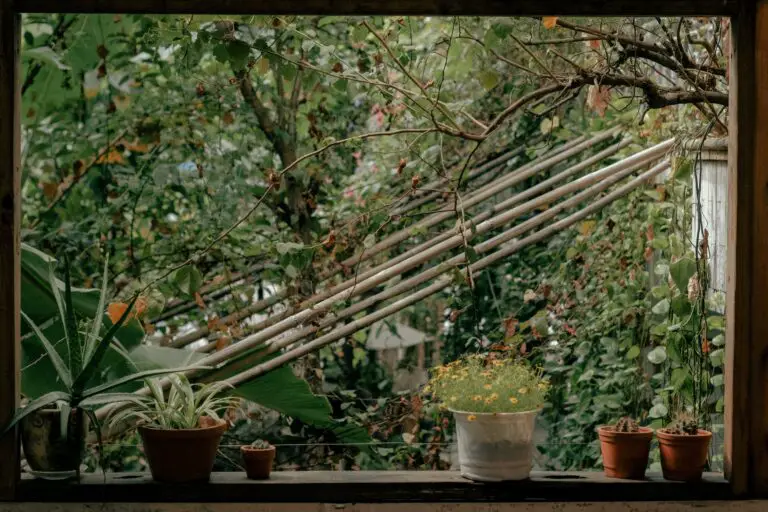
Seek out the friendly fronds of a Boston Fern or cast your gaze upon the durable and ever-tolerant Spider Plant. These champions of the non-toxic plant world serve as both aesthetic beauties and worry-free additions to households with kids or pets. They are like the kindly neighbors who mind their own business and never stir up any trouble. And who doesn’t want a neighbor like that sitting on their windowsill or bookshelf? The Boston Fern gracefully arching its fronds is as safe as a plant can be, while Spider Plants, even with their offbeat appearance, remain humble in their harmlessness.
It’s essential not to let the toxic plant list intimidate you out of bringing nature indoors. Instead, view it as a guide to unlocking an empowered choice. When planting your indoor oasis, let peace of mind take root alongside your greenery. Armed with a little knowledge and a penchant for safety, you can create an indoor jungle that’s as benign as it is breathtaking. Remember, choosing the right houseplants isn’t just about beauty—it’s about creating a harmonious and secure environment for everyone under its leaves.
Frequently Asked Questions
Are you turning your home into a green haven with luscious Crassula plants? While these jade beauties bring a touch of verdant flair to your abode, it’s natural to wonder: Is Crassula poisonous to humans? Let’s clear the air and dig into the nitty-gritty of Crassula plant safety.
Is My Beloved Jade Plant Really a Hidden Hazard?
Imagine this: You’ve just added a shimmering Crassula ovata to your collection of indoor plants, admiring its plump leaves that brim with vitality. But then, a creeping thought – could this succulent be a wolf in sheep’s clothing? In short, Crassula plants do contain toxic substances that can be harmful if ingested, making them a silent concern, particularly for curious toddlers and pets who might mistake them for a snack.
What Should I Do If Someone Ingests Crassula?
Don’t panic! While Crassula plants aren’t exactly a fruit salad ingredient, ingestion usually leads to mild symptoms such as nausea or skin irritation. However, it’s best to stay on the safe side. If you or someone you know takes a bite of this greenery, seeking medical attention is the way to go. And remember, prevention is key – keep these plants out of reach of children and educate your loved ones on the do’s and don’ts of indoor plant safety.
Unveiling Symptoms: How to Recognize a Reaction to Crassula
Let’s say a friend nibbles on a Crassula leaf during a lively game night. It might seem amusing at first, but knowing the signs of toxicity can help you act swiftly. Symptoms might include a bitter taste, a tingling sensation on the tongue, or an uninvited stomachache that crashes the party. Should such an unwelcome guest arrive, it’s time to reach out to healthcare professionals for advice.
Crassula Safety Tips: Keeping Your Green Oasis Secure
Love your leafy companions but want to maintain a safe haven? Here’s a punchy tip: treat your Crassula like a piece of fine art – splendid to gaze upon but not to touch. Inform everyone at home about the proper way to handle and care for your plants. Also, consider placing them on high shelves or in areas less frequented by kids and pets. That way, you can enjoy the lush beauty of your Crassula without any unwelcome surprises.
To give you a closer look at the precautions and benefits of indoor plants, check out this informative video:
Equipped with this knowledge and a touch of vigilance, you can continue to curate your indoor jungle with confidence and peace of mind. Remember, while Crassula may have its quirks, with proper understanding and care, it remains a splendid and safe addition to your home’s flora.
